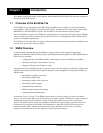
Introduction Chapter 1
EuroPak-15a Receiver User Manual Rev 5 21
Additional features for the receiver card include:
• GEO signal processing
• GPS signal processing
• Galileo signal processing
• Digital pulse blanking for the L1 signal
• Digital pulse blanking for the L5 signal
• Digital pulse blanking for the Galileo L1 signal
• Digital pulse blanking for the Galileo E5a signal
• A variant of the product, the EuroPak-15aT, is available. This variant contains a highly stable
OCXO frequency reference. The EuroPak-15aT can distribute this 10 MHz frequency reference
from its OSC port.
Galileo signal processing will only be available on activated models.
Some of these features are discussed further in the following sections.
1.5.1 GEO Signal Processing
Specific channels have the capability to receive and process the SBAS signal provided by GEOs. These signals
are in-band at L1 and L5. They are identified through the use of SBAS-specific PRN numbers. The SBAS
message is decoded and separated into its various components. The SBAS message and associated
pseudorange are provided as an output.
1.5.2 Digital Pulse Blanking
Digital pulse blanking involves removing or attenuating pulses in the RF signal that exceed a specified level.
The EuroPak-15a provides digital pulse blanking for the GPS L1, GPS L5 signal, Galileo L1 and Galileo E5a
signal paths. Digital pulse blanking reduces the negative effects of pulsed interference.
Use the PULSEBLANKING command to enable/disable pulse blanking or control its sensitivity, see Page 62.
1.6 Functional Overview
In addition to the EuroPak-15a, an GNSS receiver system typically contains three other major components:
• An antenna (and optional LNA power supply) or signal generator
• A power supply
• Data communications equipment
1.7 Internal Euro-L1E5a Card
The internal Euro-L1E5a card consists of a radio frequency and a digital electronics section.
1.7.1 Radio Frequency Section
The receiver obtains a filtered and amplified L1, L5 or E5a signal from the antenna or signal generator via the
coaxial cable. The RF section performs the translation from the incoming RF signal to an IF signal usable by
the digital section. It also supplies power to the active antenna’s LNA through the coaxial cable while


















